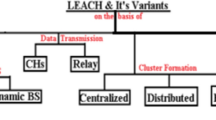Abstract
Two novel algorithms called AERO (aware of energy residue oriented) and free-AERO are proposed in this work. They are adopted in boosting the anonymity of a mobile base station (BS) and prolonging the overall lifetime of WSN (wireless sensor network). Without including in our proposed is the trivial one fixed-BS. Generally, BS play an important role of gathering data from all sensor nodes deployed over a wide WSN region. Thus, not only the BS location can be protected accordingly by the calculation of obtained data, but it makes more difficult for a malicious entity to violate the network. To complete the aforementioned objectives are the primary motivation of the proposed algorithms. On the other hand, the contribution of the proposed two algorithms is both going to boost BS anonymity and to prolong network lifetime for a WSN. Entropy and GSAT test are adopted as the criteria in system performance comparison for the deployment of AERO and free-AERO algorithms. Two scenarios with 3 × 3 and 5 × 5 cells are conducted in the simulation. Experimental results show that the proposed methods definitely boost BS anonymity and greatly prolong the network lifetime very well. Several results are illustrated and compared to previous studies for validation. When the scale of the nodes in the network becomes larger (i.e., as much as double), the method becomes more effective. The frequency of BS movement can also be adjusted with different values, 30 min, 60 min, or 90 min, to improve BS anonymity as needed.















Similar content being viewed by others
References
Paolo B, Prashant P, Vince WC, Stefano C, Alberto G, Fun Hu Y (2007) Wireless sensor networks: A survey on the state of the art and the 802.15.4 and ZigBee standards. Comput Commun 5(30):1655–1695
Raji F, Ladani BT (2010) Anonymity and security for autonomous mobile agents. IET Inf Secur 12(4):397–410
Yun Z, Yuguang F, Yanchao Z (2008) Securing wireless sensor networks: A survey. IEEE Commun 3(10):6–28
Uday A, Mohamed Y (2010) ‘Increasing base-station anonymity in wireless sensor networks’. Ad Hoc Netw (8): 791–809
Jing D, Richard H, Shivakant M (2006) Decorrelating wireless sensor network traffic to inhibit traffic analysis attacks. Elsevier Pervasive Mob Comput J 4(2):159–186
Nezhad AA, Ali M, Dimitris M (2008) Location privacy and anonymity preserving routing for wireless sensor networks. Comput Netw 52:3433–3452
Wang H, Sheng B, Li Q (2009) Privacy-aware routing in sensor networks. Comput Netw 53:1512–1529
Pfitzmann A, Hansen M (2010) ‘A terminology for talking about privacy by data minimization: Anonymity, unlinkability, undetectability, unobservability, pseudonymity, and identity, management’. Work draft Anon Terminol 8(34)
Deng J, Han R, Mishra S (2003) ‘Enhancing base station security in wireless sensor networks’, Technical Report CU-CS951-03. Department of Computer Science, Univ. of Colorado, 4
Deng J, Han R, Mishra S (2005) ‘Countermeasures against Traffic Analysis Attacks in Wireless Sensor Networks’. Secur Priv Emerg Areas Commun Netw 9
Jian Y, Chen SG, Zhang Z, Zhang L (2007) ‘Protecting receiver-location privacy in wireless sensor networks’. Comput Commun (INFOCOM 2007) (5): 1955–1963
Basagni S, Carosi A, Melachrinoudis E, Petrioli C, Wang ZM (2008) Controlled sink mobility for prolonging wireless sensor networks lifetime. Wirel Netw 14:831–858
Yang Y, Fonoage MI, Cardei M (2010) Improving network lifetime with mobile wireless sensor networks. Comput Commun 33:409–419
Young SY, Xia Y (2010) ‘Maximizing the lifetime of wireless sensor networks with mobile sink in delay-tolerant applications’. IEEE Trans mob comput 9(9)
Mirela M, Mihaela C (2008) Using sink mobility to increase wireless sensor networks lifetime. World of Wireless, Mobile and Multimedia Networks, USA, pp 1–10
Yang T, Ikeda M, Mino G, Barolli L, Durresi A, Xhafa F (2010) ‘Performance evaluation of wireless sensor networks for mobile sink considering consumed energy metric’. IEEE International Conference on Advanced Information Networking and Applications Workshops, Perth. Australia, pp 245–250
Manoj KJ, Lawrence O, Bo S, Makki SK (2011) ‘Hot spot aware energy efficient clustering approach for wireless sensor networks’. IEEE Consumer Communications and Networking Conference, Las Vegas, USA, pp 585–589
Shah RC, Roy S, Jain S, Brunette W (2003) ‘Data MULEs: Modeling a three-tier architecture for sparse sensor networks’. IEEE International Workshop on Sensor Network Protocols and Applications, pp 30–41
Kim HS, Abdelzaher TF, Kwon WH (2003) Minimum energy asynchronous dissemination to mobile sinks in wireless sensor networks. Embedded Networked Sensor Systems, Los Angeles, pp 193–204
Lai S, Ravindran B (2011) Achieving max-min lifetime and fairness with rate allocation for data aggregation in sensor networks. Ad Hoc Netw 9:821–834
Shannon CE (1948) A mathematical theory of communication. Bell Syst Tech J 27:623–656
Selman B, Levesque H, Mitchell D (1992) ‘A new method for solving hard satisfiability problems’, Proceedings of 10th National Conference on Artificial Intelligence (AAAI’92), San Jose, CA, pp 440–446
Acknowledgments
The authors would like to thank the Editor and the anonymous reviewers or their valuable helpful comments that considerably improved the quality of this article.
Author information
Authors and Affiliations
Corresponding author
Rights and permissions
About this article
Cite this article
Chen, J.IZ., Lin, CH. Algorithms for promoting anonymity of BS and for prolonging network lifetime of WSN. Peer-to-Peer Netw. Appl. 7, 710–722 (2014). https://doi.org/10.1007/s12083-012-0194-y
Received:
Accepted:
Published:
Issue Date:
DOI: https://doi.org/10.1007/s12083-012-0194-y




